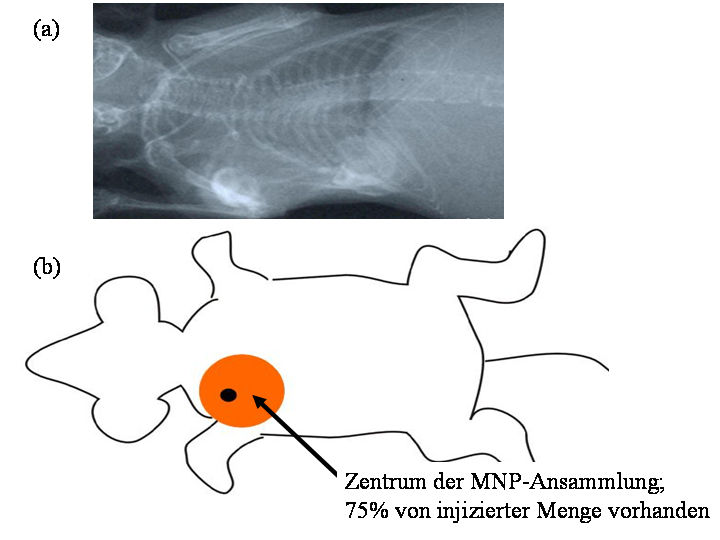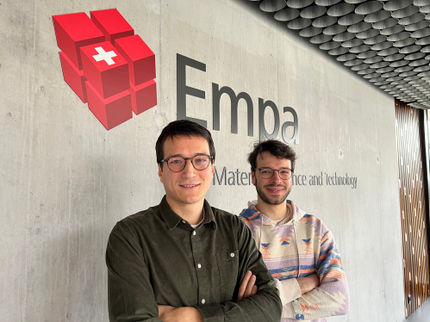How many nanoparticles heat the tumour?
PTB physicists want to improve tumour therapy by heat treatment in cooperation with biomedical physicians from Jena
Advertisement
Those who have to fight a powerful enemy must look for allies. This is why physicists from different scientific fields have decided to cooperate with biomedical physicians in order to place the fight against cancer through heat treatment by means of magnetic nanoparticles on a solid, scientific basis. It is the objective of the cooperation to improve the success of the therapy. Within the scope of a joint project funded by the Deutsche Forschungsgemeinschaft, Melanie Kettering from the Institut für Diagnostische und Interventionelle Radiologie (IDIR), University Hospital Jena, and Heike Richter from the Physikalisch-Technische Bundesanstalt (PTB) are responsible for the task of detecting where many magnetic nanoparticles can be found in the body of the patient. They are injected into the tumour - but do they really remain there or are they distributed throughout the body? Knowing how many are in the tumour is important for the success of the heat treatment. Now the scientists have been able to successfully demonstrate on mice that magnetic relaxometry is suited to be applied together with the heat treatment. It furnishes information about the whereabouts of the nanoparticles in the body - completely without contact to the patient.

24 hours after the injection, the radiography (a) shows that magnetic nanoparticles in the tumour can be found in the left shoulder of the mouse. But how many? Magnetic relaxometry (b) provides information about that. It localizes the centre of the nanoparticle accumulation - here shown as the black dot in the yellow tumour. In addition, the amplitude of the relaxation signal informs the scientist about the quantity of the particles:In this case 75 percent of the originally injected particles.
PTB
For cancer therapy by means of heat treatment, magnetic nanoparticles are injected into the tumour and excited by an external electromagnetic a.c. field. Through this, the magnetic nanoparticles generate heat inside the tumour. If temperatures between 55 °C and 60 °C are reached, cancer cells can be destroyed irreversibly. The surrounding healthy tissue (without magnetic nanoparticles) remains unaffected. The procedure has not yet found its way into clinical routine, but is still in the trial phase, as a series of questions still have to be clarified. Among other things, a procedure is required which shows where the nanoparticles are located in the body and in which quantity they can be found there. On this basis, a selective treatment of the tumour can be achieved. PTB scientists have found out that magnetic relaxometry is very well suited to obtain this information - without even touching the body of the patient or harming her/him in another way.
This is done as follows before the treatment as such is started: The ferric oxide nanoparticles injected into the tumour are superparamagnetic, i.e. they are small magnetic particles which can change their magnetization direction independently of one another. At room temperature, their orientation in the room is statistically distributed so that their sum does not form a magnetic moment. If an external constant magnetic field is now applied, they all orientate themselves almost identically in the room along the field and generate a magnetic moment which can be measured from the outside. This magnetic field is then switched off and with sensitive magnetic field sensors, so-called SQUIDs (Superconducting QUantum Interference Devices, superconducting quantum interference units), the following relaxation of the magnetization - i.e. the return of the magnetic moment from the uniform orientation towards a state with a statistic distribution - is determined extremely promptly. The amplitude of the relaxation signal then provides information about the particle quantity.
The investigations carried out so far on mice allow the conclusion to be drawn that the injection of magnetic nanoparticles and the whereabouts of the particles at the place of injection work variably well. In some tumours, the scientists could find - 24 hours after the injection - the almost complete amount of nanoparticles in the cancer, whereas in other tumours only one quarter of the injected particles could be detected. Up to now, it has not been possible to find a well-founded explanation for these different quantities of magnetic nanoparticles in the tumour. However, the result shows all the more how important it is to apply magnetic relaxometry concurrently with the heat treatment of cancer by nanoparticles to be able to make statements about the quantity of particles in the tumour.
Original publication: Richter, H.; Kettering, M.; Wiekhorst, F. et al. (2010); "Magnetorelaxometry for localization and quantification of magnetic nanoparticles for thermal ablation studies"; Phys Med Biol 55, 623-633





























































